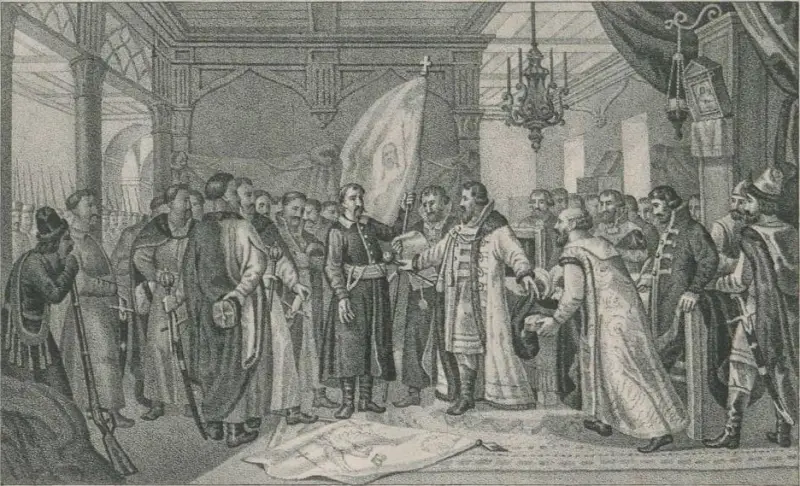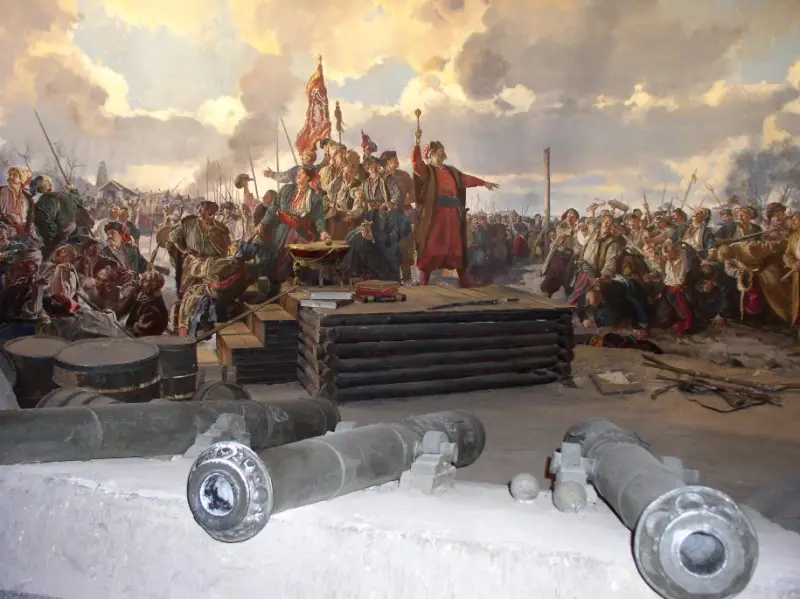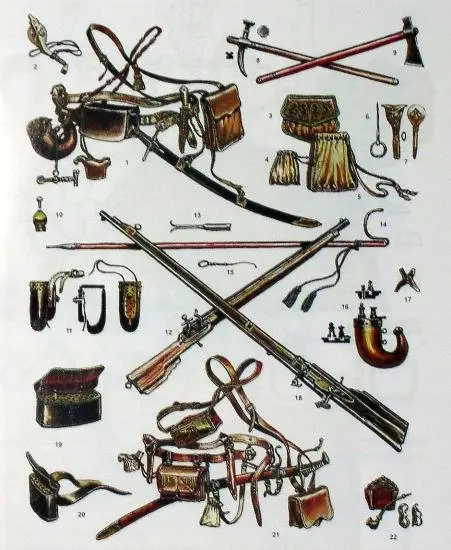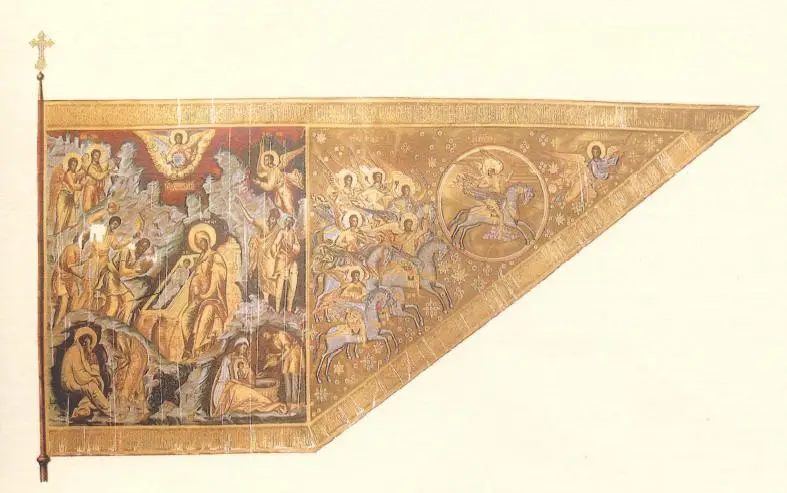How the historic decision was made to reunite the Russian land

Boyar Buturlin taking the oath of Russian citizenship from Hetman Bogdan Khmelnytsky and Ukraine. B. A. Chorikov. Picturesque Karamzin, or Russian story in pictures
General situation
The long and bloody struggle of Little Rus' with Poland bled the Russian Ukraine-outskirts. Despite a number of serious military successes (How a “romantic affair” turned into the complete destruction of the Polish army near Batog), the situation in Western Russian lands was difficult. The war completely ruined the rich Russian lands. Crop failures, locusts that destroyed crops year after year, epidemics from which tens of thousands of people died.
A pestilence swept through Western Rus'. Massive loss of life again. From the chronicle of the Samovidets:
Polish punitive forces and Crimean robbers “cleared” entire areas of people, burning, slaughtering and taking away entire towns and villages.
- shouted tycoon Stefan Czarnecki, who surpassed even the deceased Yarema Vishnewiecki in cruelty. The Russian land was exhausted in the bloody struggle.
The Poles called the inhabitants of Polish Ukraine Rusyns (Russians). Let me remind you that no mythical “Ukrainians” existed in nature at that time. Russian-Rusyns lived on the Dnieper. The history of “Ukraine” and the “Ukrainian people” was invented much later, already in the XNUMXth century.
The Polish lords tried to incite Khmelnitsky and Moscow against them, denigrating the rebel “khlops” (slaves). However, the Russian government is gradually coming to the conclusion that it is time to enter into a new war with the Kingdom of Poland. At the beginning of the Russian War of Liberation, under the leadership of Bogdan, Moscow waited, although they began to secretly help the rebel Cossacks (food, ammunition, detachments of Don Cossacks).
Firstly, the Russian kingdom itself experienced a number of internal problems. The salt riot of 1648 shocked Moscow. Unrest caused by the unsuccessful policies of the authorities, theft of nobles, rising prices for goods, and delayed salaries continued in various regions of the country: in the south, in Pomerania, in Siberia. The largest uprisings occurred in 1650 in Pskov and Novgorod.
The Russian authorities feared that by supporting the uprising in Russian Ukraine, they could get a new wave of unrest in the Russian kingdom itself. It was necessary to calm the people down, to find unity, which happened at the convening of the Zemsky Sobor in 1653, which was assembled on the occasion of the declaration of war on the Polish king John Casimir, for his violation of peaceful decisions and the acceptance of Hetman Bohdan Khmelnytsky with the Zaporozhye army under the protection of the Russian sovereign.
Secondly, the Polish authorities, magnates and gentry usually quite quickly suppressed numerous uprisings and riots in their Russian Ukraine. This time everything was different: a real large-scale war began. Khmel and his comrades proved themselves to be talented commanders and more than once inflicted heavy defeats on the Poles. Khmelya was often supported by the Crimean Horde.
Seeing that the Poles could not crush the Hetmanate, that the military power of the Polish-Lithuanian Commonwealth had noticeably weakened, Moscow decided to go to war.

Military Council of the Sich. Diorama in the Museum of the History of the Zaporizhian Cossacks, Khortytsia Island
Resolution of the issue of break with Poland and reunification
Since the beginning of the war, Khmelnitsky more than once turned to Moscow and asked to accept the Zaporozhye army under the high hand of Emperor Alexei Mikhailovich. Back on February 19 (March 1), 1651, the Zemsky Sobor in Moscow discussed the question of what answer to give the hetman. The Council apparently did not come to a definite decision. The final decision was left to the will of the king.
The Russian authorities made a last attempt to come to an agreement with Warsaw. In the spring of 1653, the embassy of boyar B. Repnin-Obolensky and okolnichy B. Khitrovo was sent to Poland. It charged the Polish government that due to the fault of the Polish-Lithuanian Commonwealth, an uprising began in Little Russia. The Russians promised to forget some violations by the Poles of the peace treaty if Warsaw made peace with Khmelnitsky on the basis of the Zboriv Treaty. The Poles had to return the property of the Russian Church, no longer oppress the Orthodox, and allow representatives of the Hetmanate to the Sejm.
The Poles played for time and began negotiations only on August 2. Moreover, without waiting for the end of the negotiations, the Polish army, led by King John Casimir, went to the Hetmanate. The embassy was not successful. The lords wanted to crush the uprising, the Sejm in Brest decided on genocide of the Russians. The Poles did not take Moscow’s diplomatic maneuvers seriously. They thought that the Russians were bluffing and were afraid of Poland. And if they try, they will be quickly defeated.
Preparing for a new battle, Khmel in the spring of 1653 sent an embassy of Burlyai and Muzhilovsky to the tsar. Once again I asked for help “by the Duma and by the sovereign’s military men” and on the acceptance of the Zaporozhye Army into Russian citizenship.
Meanwhile, Moscow has already made a decision. The mobilization of the state began. In March, letters were sent to serving people in the districts; they were ordered to arrive at the court “with all their service” by May 20. The city governors had to register the old soldiers. In addition to the already existing 15 regiments, the sovereign ordered the formation of 6 more soldier and reiter regiments. The first hussar regiment is created. New units are being recruited. There followed a call for “datochny people” (militia-warriors who performed auxiliary functions in the army).
One person was taken into the army from 1 peasant households from black volosts, palace villages, church and monastic estates; from estates whose owners were widows, girls, minors, retired, sick, crippled (if they could not marry their son or any relative). Intensified work began at the gunpowder factories. An audit of arsenals was carried out, weapon and ammunition abroad. Foreign officers were recruited in Western Europe.
Ambassador Fyodor Ladyzhensky (Lodyzhensky) was sent to Khmelnitsky. He brought the royal letter dated June 22, 1653. In it, Alexey Mikhailovich for the first time reported a positive solution to the issue of reunification of Russian lands and the war between Russia and Poland. Khmel gathered the senior council and asked: “Which land should the king or the king bow down and beat with his forehead so that he will accept them into his kingdom?” The colonels replied that they wanted to bow “to the Orthodox Christian sovereign Tsar and Grand Duke Alexei Mikhailovich of All Rus', and they do not want to serve other infidel tsars and kings and do not want to be in their faith.”
Khmelnitsky immediately sent new ambassadors to Moscow - Colonel Gerasim Yatskevich and Pavel Obramovich, who carried letters to Patriarch Nikon and the Tsar expressing joy at the reunification of the Russian land. The ambassadors left on August 9 along with Ladyzhensky.
They also prepared a response to the Ottoman Sultan, who invited Khmel to “stand under his hand.” They wrote to him that “They don’t want to be under his hand.”
As soon as the Cossack ambassadors went to Moscow with steward Ladyzhensky, the new royal ambassador Artamon Matveev arrived in Chigirin (the hetman's headquarters and capital) with confirmation of the sovereign's letter and for negotiations on preparations for reunification.
Meanwhile, the hetman in the Suceava campaign (Suceava campaign), lost his son Timothy. And his colonels, whom he wanted to send to help his son in Moldova, refused to go. Like, “It is indecent for us to defend someone else’s land and abandon our own without caution; we have enough to stand for ourselves and defend our land.” However, Khmelnitsky was once again able to survive the personal drama and gathered his will and reason into a fist, united the regiments and blocked the Polish army near Zhvanets.
The hetman, without waiting for the return of ambassadors Yatskevich and Obramovich, sends Lavrin Kapusta, the closest ally of the Subbotovsky ataman, to Moscow. He had to convey a request, “so that the sovereign ... orders his troops to be sent to them soon.” The Hetman warned the Russian government that the danger was great and if it “does not take pity” it will not help, that “The infidels... will ruin them and make them theirs.”
Kapusta arrived in the Russian capital when the embassy of Yatskevich and Obramovich had already attended a reception with the Tsar. Releasing the Cossack envoys on September 9, 1653, the Russian authorities sent with them a new embassy to the hetman, headed by the closest steward Rodion Streshnev and clerk Martemyan Bredikhin. They had to inform Bogdan that Russia’s break with Poland had occurred. Cabbage informed Khmel about the holding of the Zemsky Sobor on the issue of reunification.

Cossack weapons. Source: E. Albovsky. "Kharkov Cossacks". Kharkiv. 1895. // Republished in 2005
Decision of the Zemsky Sobor
The Zemsky Sobor (the highest class-representative institution of the Russian kingdom) was convened immediately after the departure of the embassy of Repnin and Khitrovo. Letters were sent to the outlying and suburban cities on March 19 and repeated on May 2, 1653, sending two nobles to Moscow by May 20, in the first case for the “review” of servicemen, in the second - for the Zemsky Sobor. Then, in the charters, the specified date was changed to June 2, 5. The elected representatives sent began to study the issue of the reunification of the Russian land and the war with Poland.
The meeting of the council took place in the presence of Emperor Alexei Mikhailovich on October 1, 1653, on the Feast of the Intercession of the Most Holy Theotokos, after a church service in the Cathedral Assumption Church, in the Faceted Chamber. Present at the cathedral were: Patriarch Nikon and the Consecrated Cathedral (all the highest clergy), the Boyar Duma, nobles and boyar children (service people), the living room and cloth hundred (large merchants), the Black Hundred, archers, guests and merchants of all ranks, townspeople . In historical documents, “square people” are also mentioned. Apparently, not the participants of the cathedral, but those who were on the square while the meeting was going on and expressed their attitude to the issues being resolved).
The Council had to consider two questions: about the “untruths” of the Polish king and gentry and the appeal of Hetman Khmelnitsky with a request for the reunification of Little Russia with the Russian state. Duma clerk Almaz Ivanov reported to the cathedral about “Ian Kazimir and the gentlemen are glad of the lies”who insulted the Russian sovereign and Russia. Ivanov also informed the council that the Polish king,
and tried to attract Sweden to this union. That from the Polish-Lithuanian Commonwealth began raids on the Russian border lands, that Warsaw does not take into account the peace treaty. Therefore, Russia must take measures to protect itself.
Almaz Ivanov told the cathedral about the letters of Bogdan Khmelnitsky and the entire Zaporozhye army to the tsar, which stated how the lords were torturing and oppressing the Orthodox in Little Russia. The clerk informed that the Zaporozhye “The Cherkasy people ask for mercy with many tearful petitions,” so that the king accepts them “under your sovereign’s high hand.”
The cathedral was informed that, at the request of Khmelnitsky and the entire Zaporozhye army, sovereign ambassadors were sent to Warsaw so that the king and lords would end the war and make peace with the “Cherkasy” (as the Zaporozhye Cossacks were called in Moscow). But Jan Casimir and the Lord's Rada refused to make peace. The king again leads the army to Little Russia.
That the hetman and the Cossacks are beating their heads and asking for help. Khmelnitsky asked to send the sovereign's governors and at least 3 military men to show Little Rus' that Russia was with them. He also reported that the Turkish Sultan invited him to become his citizen, but the hetman refused him and hoped for the sovereign's mercy.
When Ivanov finished his report, voting and making decisions - “verdicts” - began. The boyars and duma people were the first to cast their votes. They decided “for the honor of the blessed memory of the great sovereign, Tsar and Grand Duke Mikhail Fedorovich of All Rus' and for the honor of his sovereign’s son, the Great Sovereign Tsar and Grand Duke Alexei Mikhailovich of All Rus', to stand and wage war against the Polish king.”
Then the boyars and Duma officials granted the request of Hetman Khmelnytsky: “...so that the Great Sovereign Tsar and Grand Duke Alexei Mikhailovich of All Rus' would deign that Hetman Bogdan Khmelnitsky and the entire Zaporozhye Army with their cities and lands to accept under his sovereign high hand”. The rest of the Zemsky Sobor participants made the same “sentences.”
The age-old dream of the Russian people has come true - the Russian land has been reunited.
On October 4, 1653, it was announced to Ataman Kapusta that the tsar was sending to receive Hetman Khmelnitsky and the Zaporozhian Army his close boyar and governor of Tver Vasily Buturlin, the okolnichy and governor of Murom Ivan Alferyev and the Duma clerk Larion Lopukhin. They were entrusted with an honorable mission - to consolidate the great act of reunification of the Russian land with the oath of the people of Little Russia. Cabbage was given a letter to the hetman.
On October 9, 1653, the Russian embassy with a large retinue left Moscow. The embassy included the head of the Moscow archers with archers. Kapusta went ahead so that the embassy would be met at the border by representatives of the hetman and escorted to the army.
The embassy moved quickly, without hesitation. On October 15, the ambassadors were in Putivl, on October 27 - in Sevsk, on November 1 - in Putivl. The royal instructions were brought to Putivl. On December 3, Colonel Kalnitsky Ivan Fedorenko arrived in Putivl. He gave Buturlin a letter from the hetman, which expressed joy at the decision of the Zemsky Sobor and the arrival of the ambassadors. Bogdan asked them to wait for him in Pereyaslav until he returned to Chigirin. Chigirin was a small town; there were no supplies in it. Pereyaslav was then the second large economic and administrative center of Little Russia after Kyiv.
Khmelnytsky at that time was besieging the Polish army near Zhvanets near Kamenets-Podolsky. The 60-strong Polish army led by the king, cut off from fortresses and bases, was threatened with complete defeat. The Poles were starving. But the Crimean Khan, even here, as at Zborov, betrayed the hetman (How Islam-Girey prevented Khmelnitsky from destroying the Polish army near Zhvanets).
Having learned about the decision of the Zemsky Sobor, Islam-Girey, frightened by the unification of the Russian lands, hastened to come to an agreement with the Polish king. On December 5, 1653, the Zhvanetsky Treaty was concluded. The Poles paid the Crimeans a large indemnity and allowed them to take yasyr (full) and plunder Volyn for 40 days.
To keep Khmel from an alliance with Russia, the khan suggested that he also make peace with the king on the terms of the Zborov Treaty. Jan Casimir was forced to agree to such a peace, but, as before, the Poles were not going to put up with the rebellion of the “claps”. For this, the Cossacks, together with the Crimeans and Poles, were supposed to attack Russia in the spring of 1654.
Khmelnitsky refused. Having gathered the Rada and discussed the situation, the Cossacks decided to return.

Banner of the Great Regiment of Tsar Alexei Mikhailovich 1654
Information